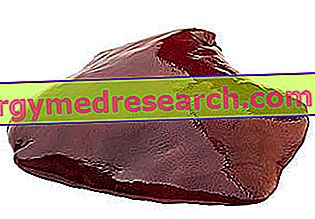What are Sea Truffles
Generalities on sea truffles
Sea truffles (in English "sea truffle") are fishery products zoologically classified as marine bivalve molluscs.

Widely used and appreciated in Italian cuisine as well as abroad, they are fished using large fishing boats equipped with special bottom dredgers.
The use of dredges is considered highly harmful because, destroying everything they encounter, the greater concentration of sea truffles close to the Posidonia meadows, inexorably compromises the integrity of the plants, hindering marine oxygenation and destroying the entire niche biological.
Less famous than clams, mussels and oysters, even sea truffles belong to the first fundamental group of foods (sources of high biological value proteins, vitamins - such as group B and vit A - and specific minerals - such as iron), iodine, etc.). They lend themselves to most diets but may have contraindications which we will discuss later.
Sea truffles are edible cooked and raw; they are worked in a similar way to other bivalve molluscs (including razor clams, cockles, cockle hearts, cockles etc.) and, to be considered hygienically safe, they require a guarantee of good quality.
Description
Description of sea truffles
Sea truffles are molluscs enclosed between two shells. The casing, apparently similar to that of the clams (bi-valve), is however more rounded, rounded and with a knurled surface. Atlantic sea truffles reach 6-7 cm in length and 60-70 g in weight; in the Mediterranean, the most common specimens are 3-4 cm for 30-40 g. They differ from the fasolari (even larger) due to the shell color (externally they have shades ranging from light yellow to beige-brown or even reddish; the interior is white and glossy) and due to the irregular surface composed of ridges or lamellas ( about 50 per side) that follow the shells horizontally.
The internal mollusk is very similar to that of the clam. The foot is large and shaped like a "tongue". The siphons are short, dark, of unequal length and fused together. They do not have bright red shades such as fasolari, mussels or cockle.
Sea Truffle Nutritional Properties
Nutritional characteristics of sea truffles
Source of proteins with high biological value, specific vitamins and minerals, sea truffles belong to the first fundamental group of foods.
The information available on the chemical profile of sea truffles is quite limited. On the other hand, given the close similarity of the various foods in the category, it is possible to make hypotheses, if not certain, at least plausible.
Sea truffles should be low-calorie foods (about 85 kcal / 100 g of edible portion) whose energy is supplied mainly by peptides, followed by a very small amount of carbohydrates and an almost irrelevant percentage of lipids. Proteins have a high biological value, that is they contain all the essential amino acids in the right quantities and proportions (compared to the human model). It is likely that carbohydrates are essentially complex, ie consisting of glycogen. The profile of fatty acids should favor unsaturated fats, with a possible appreciable level of omega 3 (eicosapentaenoic acid and docosahexaenoic acid).
As with other bivalve molluscs, the amount of cholesterol should be significant. Fibers and prebiotics are logically absent. Sea truffles, which cause allergies in the population quite frequently, are on the other hand totally free of lactose and gluten (nutrients responsible for food intolerance). It is possible that the histamine concentration is more than relevant.
Among the vitamins there should be excellent levels of water-soluble B group (thiamine or B1, riboflavin or B2, niacin or PP, pantothenic acid or B5, pyridoxine or vitamin B6, cobalamin or B12), probably also a good concentration of retinol equivalent ( provitamin A) and, perhaps, vitamin D (colecalciferol).
As for minerals, sea truffles should contain appreciable levels of: potassium, phosphorus, sodium, iron, calcium, magnesium, zinc, selenium, copper and iodine.
Sea truffles in the diet
Sea truffles lend themselves to most diets, except for specific allergies and, as a precaution, for histamine intolerance. Note : if the concentration of the latter in fresh sea truffles is still to be defined, in case of poor storage it is certainly very high.
Sea truffles in metabolic pathologies
They are ideal for the low-calorie diet against obesity. They have no contraindications in the food therapy of type 2 diabetes mellitus and hypertriglyceridemia. In the case of hypercholesterolemia, on the other hand, it is better not to overdo it by following the frequency of consumption and the recommended portions (which we will specify later). Due to the high quantity of sodium (contained in sea water) they should be consumed in moderation in primary sodium sensitive arterial hypertension; in this case it is always advisable to remove most of the cooking water from the pan. Excessive portions of sea truffles should also be avoided by those suffering from hyperuricemia, especially severe, decompensated and characterized by frequent gout attacks. These molluscs are clearly not recommended in the low purine diet but, in this case, it is reasonable to consume them in moderate quantities.
Digestibility of sea truffles
Recall that all bivalves contain a high percentage of connective tissue, which makes them less digestible and, in high portions, contraindicated in the diet against stomach diseases and discomfort (dyspepsia, gastritis, ulcer, hiatal hernia with gastroesophageal reflux disease etc.).
Other dietary implications of sea truffles
Sea truffles are very nutritious foods. They can be a valid alternative to meat, eggs and cheese; on the other hand, their frequency of consumption is to be considered sporadic and cannot entirely constitute that of the entire group of fishery products (in which, on the other hand, small or medium-sized blue fish should prevail).
Containing many fairly rare nutrients in the diet, including several minerals and vitamins, sea truffles lend themselves to feeding children, the elderly, sportsmen and, well cooked (never raw), even pregnant ones.
The average portion of sea truffles, intended exclusively as an edible part, is about 50-100 g (45-85 kcal); raw, still with shell, correspond to about 200-400 g.
Safety
Hygienic safety of sea truffles
Sea truffles are foods potentially at risk of contamination. Living in the sea and filtering water to feed on some micro and macro plant organisms such as phytoplankton (plankton microalgae) and very small multicellular algae, these bivalve molluscs tend to accumulate pathogens and pollutants.
The greatest risk with regard to pathogens is given by the potential transmission of HAV (hepatitis A virus), Vibrio cholerae, Escherichia coli and algal toxins. With regard to pollutants, on the other hand, specific reference is made to dioxins (residues of plastic degradation) and the like, as well as to certain metals such as mercury (fortunately scarce in these animals with a rather short life cycle).
The HAV virus and bacteria such as cholera or coliforms are abundant in the polluted water of sewage discharges, especially untreated. They die with cooking, which is always necessary to ensure maximum healthiness of food, but it is still a good idea to avoid sea truffles caught in areas at risk. The cooking of these foods, in fact, is not always performed in a deep and total manner, to maintain the organoleptic and gustatory characteristics of the product.
The concentrations of algal toxins and pollutants on the other hand vary greatly depending on the area of collection. In general, high-density areas of these elements are prohibited from commercial fishing to prevent the placing on the market of unsuitable products.
It is therefore always necessary to procure from official and safe commercial sources, to reduce the risk of unpleasant incidents harmful to health.
Kitchen
How to cook sea truffles?
Sea truffles are particularly appreciated in all the countries bordering the Mediterranean, in Brittany and in Normandy. Every year several thousand tons of sea truffles are sold locally, without this having affected the population density of the molluscs.
In Italy, the sea truffle is present on all the coasts of the peninsula. It is especially common in the Veneto, Emilia Romagna, Friuli Venezia Giulia, Puglia and Campania regions.
Sea truffles, to be bought strictly alive, can be found on the market already housed and therefore purified from sand and from possible residues of pathogens and contaminants. They are cooked exactly like the clams; they do not require any preliminary processing (they must not be opened with the knife like the fasolari) except for the verification of any broken shells that can damage the teeth and mucous membranes of the mouth.
Did you know that ...
At the time of purchase, noting that the valves of sea truffles remain ajar and that the weight is strangely less than what is indicated in the package (a sign that the shellfish have lost all the water inside), it is better not to buy them. The sea truffles in question are certainly old, dying and of poor quality.
The simplest way to taste sea truffles is to open them in a pan, with hot oil, garlic, parsley and pepper or chilli pepper; to avoid salt. Once opened, it is advisable to set aside the liquid (which will then be filtered with gauze to hold the sand) and blend them with a little dry white wine. In this way, by reusing the cooking water, it is possible to enjoy an excellent hot appetizer (sauté of sea truffles). Needless to specify that it is also an excellent condiment for pasta (spaghetti). Many choose to add fresh tomato, pureed, peeled or chopped. Along with other sea ingredients, truffles can also structure more complex recipes (rock sauce, spoon polenta sauce, soups and broths, etc.).
If previously opened with a paring knife (small knife), they can be filled with aromatic bread and baked in the oven.
Some like raw sea truffles, seasoned with a little lemon juice or natural; recently, a number of seasonings have also been introduced that are different from the typical oriental flavor (such as wasabi or other spices).
Biology
Notes on zoology on sea truffles
Sea truffles are aquatic creatures belonging to the Phylum Mollusca, Class Bivalvia, Family Veneroidae, Genus Venus and verrucous species. The binomial nomenclature of sea truffles is Venus verrucosa .
The distribution area of sea truffles extends, in the Eastern Atlantic, from the coasts of Norway to South Africa. They are also found in the islands of Cape Verde, Canary Islands, Madeira and throughout the Mediterranean Basin.
Sea truffles live in colonies buried from the bottom, on coarse sediments (in the Ocean), sandy or muddy (especially in the Adriatic Sea), mainly in correspondence of the Posidonia meadows (marine plant responsible for water oxygenation). In the Mediterranean Basin they are around 20 m deep but, above all in the Ocean, they can colonize depths up to 100 m. They feed on plankton, more precisely of phytoplankton, and of small multicellular algae that filter through the siphons. Among their most voracious natural predators we find some starfish.
The reproduction of sea truffles, uninterrupted in some areas such as southern Spain, is instead seasonal elsewhere, especially in the Mediterranean basin. The phenomenon is probably regulated by water temperature and phytoplankton flows; in Italy, south of the Adriatic and in the Tyrrhenian Sea, they reproduce between the end of spring and the beginning of summer.
Ecology of sea truffles
Sea truffles are not considered an endangered species. However, for fishing (especially in the ocean) special dredges are used mounted on fishing vessels. As we have said, sea truffles live in colonies near the Posidonia meadows. Dredging this vegetation, professional fishermen damage the marine ecosystem because water oxygenation is reduced and whole biological niches are destroyed.
Instead, hand fishing is advised by divers, a practice which however would exponentially increase the retail cost of sea truffles.



